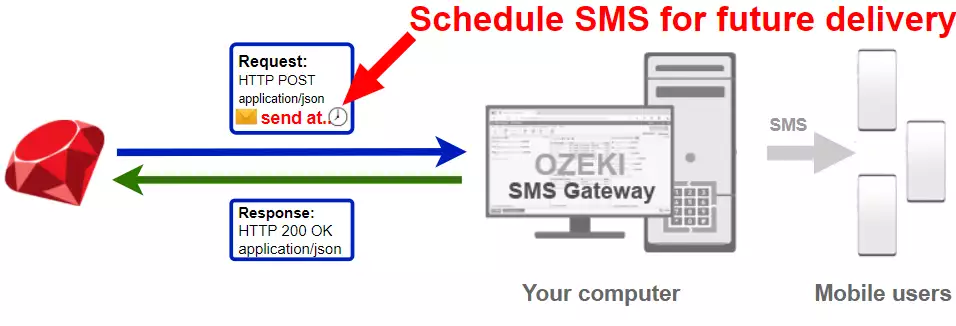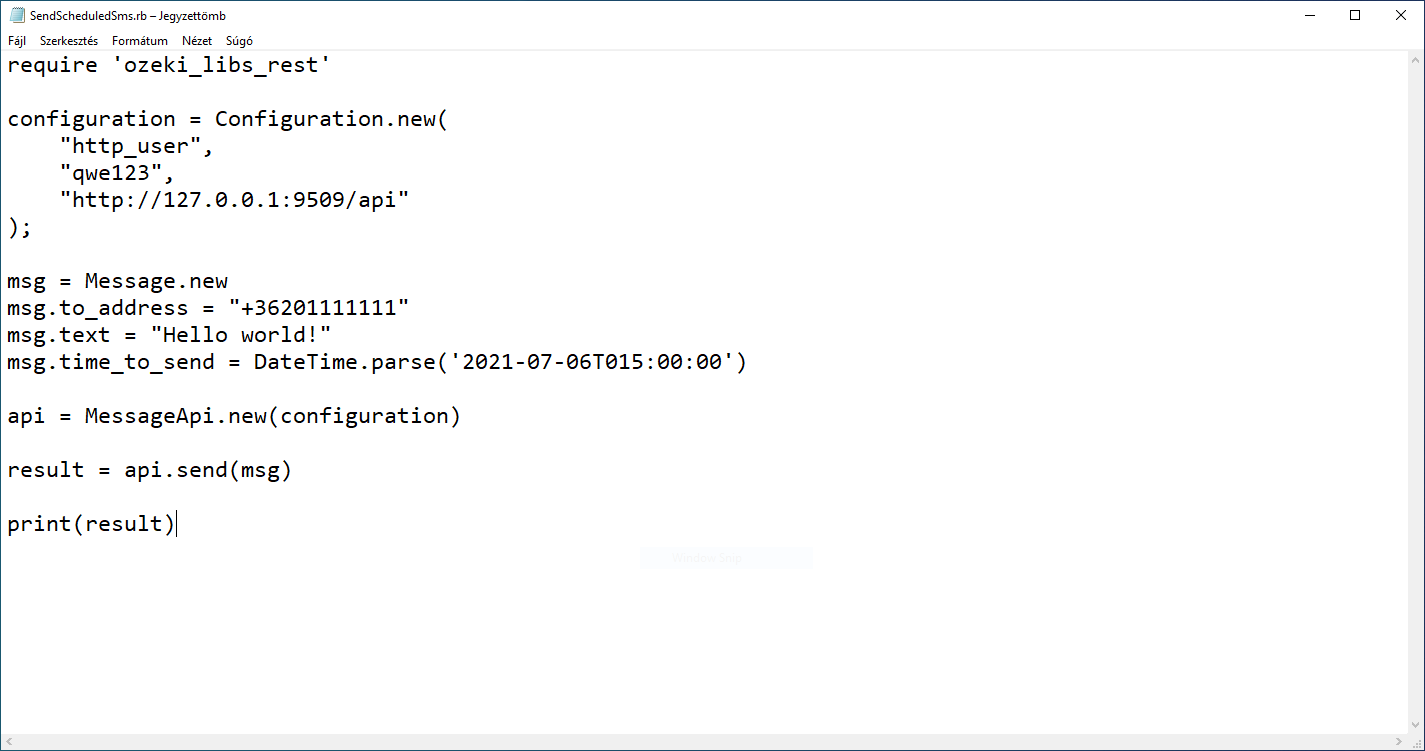How to schedule an SMS in Ruby
The simplest way to send a scheduled SMS from Ruby is to use the built in HTTP/Rest SMS api of Ozeki SMS Gateway. When you use this API, you will send SMS messages by issuing a HTTP Post request to the SMS gateway. The HTTP Post request will contain a message formatted in json format. The SMS gateway will send this SMS to the recipient's phone, and it will return a HTTP 200 OK response to your request.

Ruby code to send schedule sms to mobile
The Ruby sms code sample below demonstrates how you can send a scheduled SMS using the http rest sms api of Ozeki SMS Gateway using the Ruby ozeki_libs_rest gem. This library is provided to you free of charge, and you may use it and modify it in any of your projects.
SendScheduledSms.rb
require 'ozeki_libs_rest'
configuration = Configuration.new(
"http_user",
"qwe123",
"http://127.0.0.1:9509/api"
);
msg = Message.new
msg.to_address = "+36201111111"
msg.text = "Hello world!"
msg.time_to_send = DateTime.parse('2021-07-06T013:00:00')
api = MessageApi.new(configuration)
result = api.send(msg)
print(result)
How to use the Ruby sms example:
This Ruby sms example can be used in any ruby application. To use it, you must download the ozeki_libs_rest gem. After the gem is downloaded, you need to add a reference to it in your Ruby source code. This will allow you to use the classes provided by the ozeki_libs_rest gem. You can use the Message class to create the SMS. You can use the MessageApi class to send the SMS to the SMS gateway. The SMS gateway will forward your message to the mobile network either through a wireless connection or through the Internet.
Download SendScheduledSms.rb
The source code explained in this article can be downloaded and used and modified free of charge.
Download: SendScheduledSms.rb.zip (373B)
What is in the SendScheduledSms.rb.zip file?
The SendScheduledSms.rb.zip contains the SendScheduledSms.rb file, which contains the example code to show you how to send an SMS. This example code is listed below.

How to send a scheduled sms from Ruby (Quick steps)
To send a scheduled sms from Ruby:
- Download the SendScheduledSms.rb.zip file
- Extract the .zip file from Downloads folder
- Open the SendScheduledSms.rb file in any text editor like windows notepad
- Launch Ozeki SMS Gateway
- Create a HTTP API user in Ozeki
- Run SendScheduledSms.rb Ruby code using the command prompt
- Check the Sent box in Ozeki SMS Gateway
Install Ozeki SMS Gateway and create an HTTP API user
To be able to send SMS from Ruby, first you need to install Ozeki SMS Gateway. The SMS gateway can be installed on the same computer, where you develop your Ruby code in Visual studio. After installation, the next step is to connect Ozeki SMS Gateway to the mobile network. You can send a test sms from the Ozeki GUI to verify, that your mobile network connection works. The final step to prepare your environment is to create a HTTP sms api user. Create a user with a username of "http_user", and with a password of "qwe123" to make the example work without modification.
After the environment is setup, you can run your Ruby code.
HTTP API url to use send sms from Ruby
To send SMS from Ruby, your Ruby will have to issue an HTTP request to the SMS gateway. The API url is shown below. Note that the IP address (127.0.0.1) should be replaced to the IP address of your SMS gateway. If Ozeki SMS Gateway is installed on the same computer where the Ruby sms application is running, this can be 127.0.0.1. If it is installed on a different computer, it should be the IP address of that computer.
http://127.0.0.1:9509/api?action=rest
HTTP authentication to use send sms from Ruby
To authenticate the Ruby sms client, you need to send the username and password in a base64 encoded string to the server in a HTTP request. The format used is: base64(username+":"+password). In Ruby you can use the following code to do this encoding:
username_password = username + ':' + password username_password_encoded = Base64.encode64(username_password) 'Basic ' + username_password_encoded
For example, if you encode the username 'http_user' and the password 'qwe123', you will get the following base64 encoded string: aHR0cF91c2VyOnF3ZTEyMw==. To send
HTTP request header to send SMS from Ruby
To send the SMS messages, you need to include the following lines as headers in the HTTP request. Note that we include a content type and an Authorization header.
Content-Type: application/json Authorization: Basic QWxhZGRpbjpvcGVuIHNlc2FtZQ==
HTTP request to send SMS from Ruby
To submit the SMS, your Ruby application will send an HTTP request similar to the one below. Note, that this request contains a HTTP header part and a http body part. The HTTP body is a JSON encoded data string. It contains the recipient's number and the message's text.
POST /api?action=sendmsg HTTP/1.1
Content-Length: 339
Content-Type: application/json
Accept: application/json
Accept-Encoding: gzip;q=1.0,deflate;q=0.6,identity;q=0.3
Authorization: Basic aHR0cF91c2VyOnF3ZTEyMw==
Host: 127.0.0.1:9509
User-Agent: Faraday v1.5.0
{
"messages": [
{
"message_id": "f0f02105-0a78-46a9-ae14-f0728bac2aa6",
"to_address": "+36201111111",
"text": "Hello world!",
"create_date": "2021-07-06T14:32:21",
"valid_until": "2021-07-13T14:32:21",
"time_to_send": "2021-07-06T13:00:00",
"is_submit_report_requested": true,
"is_delivery_report_requested": true,
"is_view_report_requested": true,
"tags": []
}
]
}
HTTP response received by the Ruby sms example
Once the SMS gateway receives this request, it will generate a HTTP response. The HTTP response will contain a status code, to indicate whether the SMS submit request was successful or not. It will also return a JSON encoded structure to provide you useful details about the message's submission.
HTTP/1.1 200 OK
User-Agent: OZEKI 10.3.123 (www.myozeki.com)
Content-Type: application/json; charset=utf8
Last-Modified: Tue, 06 Jul 2021 14:26:41 GMT
Server: 10/10.3.123
Transfer-Encoding: chunked
{
"http_code": 200,
"response_code": "SUCCESS",
"response_msg": "Messages queued for delivery.",
"data": {
"total_count": 1,
"success_count": 1,
"failed_count": 0,
"messages": [
{
"message_id": "f0f02105-0a78-46a9-ae14-f0728bac2aa6",
"from_station": "%",
"to_address": "+36201111111",
"to_station": "%",
"text": "Hello world!",
"create_date": "2021-07-06 14:32:21",
"valid_until": "2021-07-13 14:32:21",
"time_to_send": "2021-07-06 13:00:00",
"submit_report_requested": true,
"delivery_report_requested": false,
"view_report_requested": false,
"tags": [
{
"name": "Type",
"value": "SMS:TEXT"
}
],
"status": "SUCCESS"
}
]
}
}
Ruby sms example: SendScheduledSms.rb
In the following video, we present you with the process of downloading the source code of the project. The video will start with downloading the project files and will take you all the way to the opened project file. The video will show you how to download the project file and open it with the help of Notepad. This 36-seconds-long video is detailed and contains all the information you need to successfully complete the download process
The example code
The example code below is part of the SendScheduledSms.rb. You can modify the example project by finding the correct line and replacing a code part with the correct data. For example, the msg.to_address variable holds the phone number where the message will be delivered (Figure 3). The msg.text variable holds the text of the message. Modify it to your liking and run the project to send a test message.

How to send scheduled SMS using Ruby (Video tutorial)
In this video, we are going to show you the process of running the example project. The video will start with the prepared source code and will end with the log of the scheduled SMS. The video will teach you how to provide a time for sending the message and the configuration you need to do in the command prompt. This video is only 1:30 long but very detailed. You will learn all the crucial steps you need to take to schedule an SMS. We are using the Ozeki SMS Gateway in this video, so you will be working with a very intuitive user interface. You will have no problem with following the steps.
Conclusion
The article above showed the steps of SMS scheduling in Ruby language with the help of Ozeki SMS Gateway. With this solution, the perfect timing of SMS delivery is possible, leading to higher performance and a customer friendly image. The recipients get the messages when they are not in their busy hours, so they have time to read them. Ozeki SMS Gateway is a very reliable software, and it can be managed very easily.
Continue the reading on Ozeki's tutorial page where more information can be found about similar topics, like SMS deleting and receiving in Ruby.
The only thing to do now is to download Ozeki SMS Gateway and let the work begin!
